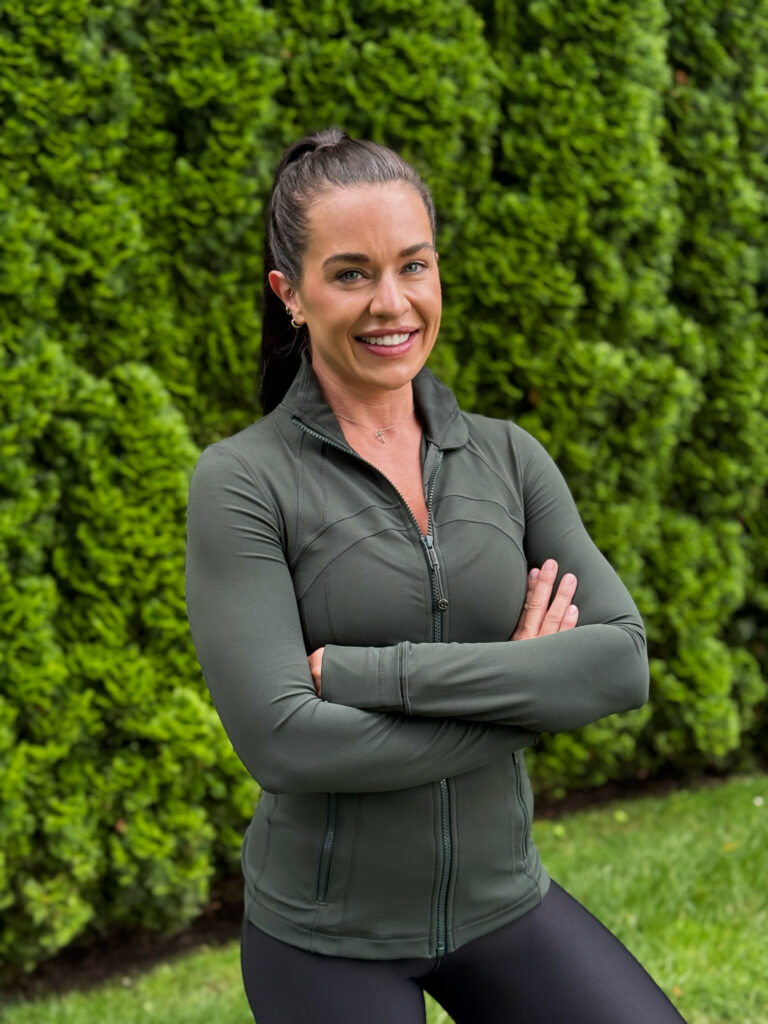- Why Muscle Matters
- 3 Weight Training Myths I Hear Often
- If You’re Short on Time, Smarter is Better
- The 5 Foundational Moves I Recommend
- The Takeaway: Train for Tomorrow
- About Emily
By Emily Hoffman, ResetOne Head of Fitness
Muscle isn’t just a fitness goal; it’s your most powerful tool for aging well.
We’ve been taught to chase calorie burn and weight loss, but when it comes to longevity, muscle is what truly moves the needle.
As someone who works closely with people at all stages of life and fitness, I’ve seen firsthand how building muscle doesn’t just change your body: it transforms how you feel, function, and age.

Why Muscle Matters
Muscle is metabolically active, which means it helps your body burn more energy even when you’re at rest. But it does much more than that.
Here’s why building and maintaining muscle is one of the smartest longevity moves you can make:
- Boosts metabolism: Muscle increases your resting energy expenditure, helping you burn more calories all day.
- Improves blood sugar control: It acts as a glucose sink, pulling sugar out of your bloodstream and lowering inflammation.
- Protects against aging: Strong muscles reduce your risk of falls, frailty, and mobility loss as you age.
- Balances hormones: Resistance training supports growth hormone, testosterone, and estrogen regulation: all key to mood, libido, and resilience.
Muscle is your metabolism. Your mobility. Your mood stabilizer. And your best protection as you age.
Muscle isn’t optional; it’s essential. And the best time to start building it was yesterday. The second-best time is today.
3 Weight Training Myths I Hear Often
“I don’t want to get bulky.”
This is one of the most common misconceptions I hear; especially from women. The truth is it’s difficult to bulk up unless you’re actively training for it and eating with that goal in mind. Women simply don’t produce enough testosterone to build large muscle mass easily. What you will build is lean, defined muscle that supports your metabolism, posture, energy, and confidence.
“I will have to lift frequently day to see results.”
Not true, and actually, often counterproductive. Your body needs time to recover and rebuild between sessions. Three to four well-designed strength workouts per week are more than enough for most people, especially when combined with quality sleep, recovery, and smart nutrition. More is not better; better is better.
“Cardio is better for fat loss.”
Cardio has benefits, but when it comes to long-term fat loss and metabolic health, strength training wins. This is because muscle increases your resting metabolic rate, meaning you burn more calories even when you’re not working out. Building muscle also helps regulate blood sugar, reduce inflammation, and improve hormone function, which are all key factors in sustainable weight management.
If You’re Short on Time, Smarter is Better
You don’t need hours in the gym to build strength. What matters most is how you train.
I always recommend compound movements: exercises that work multiple muscle groups at the same time. Exercises like squats, lunges, deadlifts, presses, and pulls. These movements mimic how we move in real life (picking things up, climbing stairs, getting off the floor) and they train your body as a whole, not in isolated parts.
The benefit is getting a bigger return on your effort. Compound exercises burn more calories, recruit more muscle fibers, and build functional strength that supports everyday activities. They’re especially effective if you’re short on time and want to make every minute of your workout count.
In other words: if you only have 30 minutes, these are the moves that matter most.
The 5 Foundational Moves I Recommend
These are the foundational movements I recommend to nearly every ResetOne member. They train your biggest muscle groups, support your joints, and set the stage for everything from athletic power to healthy aging.
Each video demonstration below shows you how to perform the movement with proper form and control.
These movements assume you have access to a gym or training facility with weights, but you can start with just your body weight and some heavy items around the house, like a milk gallon or a bag filled with books.
As you go through the movements, aim to finish each set with 1–2 reps in reserve (RIR). That means you stop when you could do one or two more reps with good form, but no more than that. This is a simple, proven way to train with enough intensity to build muscle, without overdoing it.
If you’re new to weight training or unsure about your form, it’s always a good idea to have someone experienced nearby, whether that’s a trainer, training partner, or friend; especially when working with free weights.
1. Hip Thrusts
Builds glutes, strengthens your hips, and protects your lower back.
What it is: A movement where you drive your hips upward while your upper back is supported on a bench or floor. The goal is to squeeze your glutes at the top and keep your core engaged.
- Beginner: Glute bridges (on floor, bodyweight)
- Progression: Barbell hip thrusts, single-leg variations, or pause reps
2. Romanian Deadlifts (RDLs)
Strengthens your entire posterior chain: hamstrings, glutes, and lower back.
What it is: A controlled hip-hinge movement where you lower weights down the front of your legs with a slight bend in the knees, keeping your spine long and your back flat.
- Beginner: Light dumbbells, reduced range of motion
- Progression: Barbell RDLs, single-leg RDLs, slow tempo work
3. Chest Press
Targets chest, shoulders, and triceps; great for posture and upper-body strength.
What it is: A pushing movement where you press weight away from your chest, either lying on the floor, a bench, or at an incline.
- Beginner: Dumbbell floor presses or incline push-ups
- Progression: Barbell bench press, alternating dumbbells, deficit push-ups
4. Pull-Ups (or Assisted Variations)
Builds back, biceps, core, and grip; critical for functional strength and posture.
What it is: A vertical pulling movement where you lift your body toward a bar using upper-body strength. Assisted options make this scalable for all levels. Changing your grip also makes this exercise dynamic.
- Beginner: Band-assisted pull-ups, TRX rows, lat pulldowns
- Progression: Full pull-ups, slow negatives, or weighted reps
5. Lunges
Train legs, core, and balance, and corrects side-to-side strength imbalances.
What it is: A single-leg exercise where you step forward, backward, or sideways into a lunge, keeping your torso upright and knees aligned.
- Beginner: Static split squats, assisted lunges
- Progression: Walking lunges, Bulgarian split squats, reverse lunges with dumbbells
The Takeaway: Train for Tomorrow
Muscle isn’t just for athletes or fitness fanatics. It’s for anyone who wants to move better, feel stronger, and age with power and confidence.
Muscle isn’t optional, it’s essential.
You don’t need to be perfect. You just need to start.
Want to Go Deeper?
I joined Dr. Eric Fete, one of ResetOne’s founding physicians and a true expert in muscle medicine, for our second episode of Living Room Longevity, where we talked everything muscle. You can catch the replay and access Dr. Fete’s accompanying white paper here.
Let’s change the way you age, starting with strength.
About Emily
Emily brings over 13 years of elite coaching and movement expertise to ResetOne’s longevity mission. With a background spanning Equinox to boutique training agencies, she excels at translating advanced performance science into real-world strength, mobility, and resilience. As a former competitive athlete and dedicated trainer, Emily knows how to build sustainable systems that support strength not just today but for decades to come.




